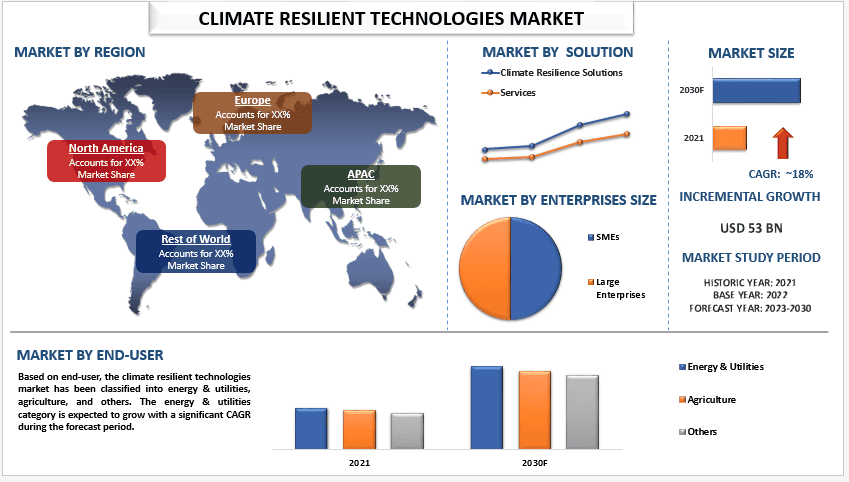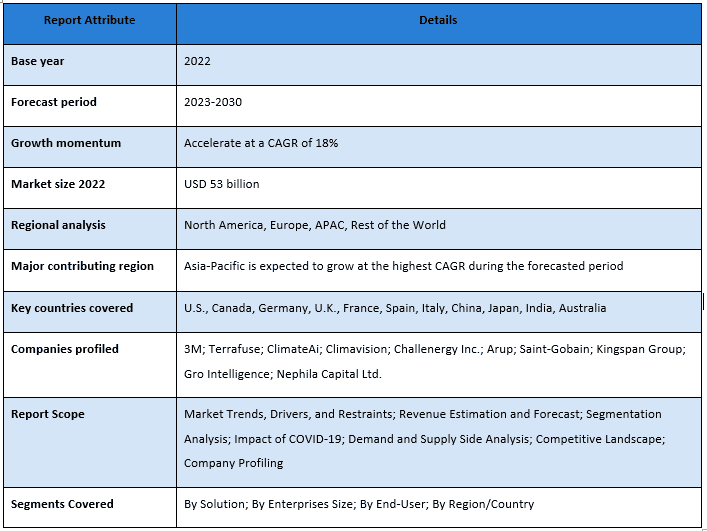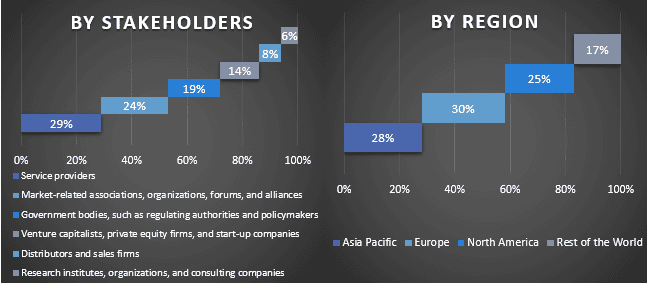- Trang chủ
- Về chúng tôi
- Ngành
- Dịch vụ
- Đọc
- Liên hệ với chúng tôi
Thị trường Công nghệ Bền vững với Biến đổi Khí hậu: Phân tích Hiện tại và Dự báo (2023-2030)
Chú trọng vào Giải pháp (Các Giải pháp và Dịch vụ về Khả năng Chống chịu Khí hậu {Tích hợp & Triển khai, Dịch vụ Tư vấn, và Hỗ trợ & Bảo trì}); Quy mô Doanh nghiệp (SMEs và Doanh nghiệp Lớn); Người dùng cuối (Năng lượng & Tiện ích, Nông nghiệp, và Khác); và Khu vực/Quốc gia

Thị trường Công nghệ Bền vững với Khí hậu Toàn cầu được định giá 53 tỷ USD vào năm 2022 & dự kiến sẽ tăng trưởng với tốc độ CAGR là 18% từ năm 2023-2030. Công nghệ Bền vững với Khí hậu được định nghĩa là các giải pháp sáng tạo và linh hoạt có thể giúp giảm thiểu tác động của biến đổi khí hậu và làm cho cộng đồng kiên cường hơn trước những tác động của nó. Các công nghệ này được thiết kế để chịu được các sự kiện khí hậu khắc nghiệt như mực nước biển dâng và các thách thức khác liên quan đến biến đổi khí hậu. Để đảm bảo nguồn cung cấp nước và năng lượng độc lập cho các công trình lắp đặt nông thôn vùng sâu vùng xa cũng như sử dụng liên tục trong các trường hợp khẩn cấp, các công nghệ như quang điện mặt trời, máy bơm nước và chuỗi tiêm chủng có thể tăng cường khả năng phục hồi. Các yếu tố như chuyển đổi sang các nguồn năng lượng tái tạo như mặt trời, gió và thủy điện có thể giảm phát thải carbon và sự phụ thuộc vào nhiên liệu hóa thạch một cách hiệu quả. Các công ty lớn trên thị trường cung cấp các công nghệ bền vững với khí hậu với các tính năng công nghệ tiên tiến. Ví dụ: vào tháng 10 năm 2022, Apple đã kêu gọi chuỗi cung ứng toàn cầu khử carbon vào năm 2030. Công ty đã đẩy nhanh công việc với các nhà cung cấp để khử carbon trong quá trình sản xuất liên quan đến Apple và mở rộng đầu tư vào năng lượng sạch và các giải pháp khí hậu trên toàn thế giới.
3M; Terrafuse; ClimateAi; Climavision; Challenergy Inc.; Arup; Saint-Gobain; Kingspan Group; Gro Intelligence; Nephila Capital Ltd là một số công ty chủ chốt trên thị trường. Một số thương vụ M&A cùng với quan hệ đối tác đã được các công ty này thực hiện để tạo điều kiện cho khách hàng có được các sản phẩm/công nghệ công nghệ cao và sáng tạo.
Thông tin chi tiết được trình bày trong báo cáo
“Trong số các giải pháp, danh mục Giải pháp Khả năng phục hồi khí hậu dự kiến sẽ tăng trưởng với CAGR đáng kể trong giai đoạn dự báo”
Dựa trên giải pháp, thị trường được phân khúc thành Giải pháp và Dịch vụ Khả năng phục hồi khí hậu {Tích hợp & Triển khai, Dịch vụ Tư vấn và Hỗ trợ & Bảo trì}. Danh mục Giải pháp Khả năng phục hồi khí hậu dự kiến sẽ tăng trưởng với CAGR đáng kể trong giai đoạn dự báo. Các giải pháp phục hồi khí hậu nhằm mục đích giúp các doanh nghiệp và cộng đồng đối phó với những tác động của biến đổi khí hậu, chẳng hạn như các sự kiện thời tiết khắc nghiệt, mực nước biển dâng hoặc hạn hán. Các công nghệ này có thể giúp giảm phát thải khí nhà kính, cải thiện hiệu quả năng lượng và tăng cường khả năng phục hồi của cơ sở hạ tầng quan trọng.
“Trong số những người dùng cuối, danh mục năng lượng & tiện ích dự kiến sẽ tăng trưởng với CAGR đáng kể trong giai đoạn dự báo”
Dựa trên người dùng cuối, thị trường công nghệ bền vững với khí hậu đã được phân loại thành năng lượng & tiện ích, nông nghiệp và các loại khác. Danh mục năng lượng & tiện ích dự kiến sẽ tăng trưởng với CAGR đáng kể trong giai đoạn dự báo. Điều này chủ yếu là do sự gia tăng đầu tư vào công nghệ bền vững với khí hậu như lưới điện thông minh, các nguồn năng lượng tái tạo và hệ thống lưu trữ năng lượng. Công nghệ này có thể giúp cải thiện hiệu quả và độ tin cậy của việc cung cấp và dịch vụ năng lượng, giảm phát thải khí nhà kính đồng thời cải thiện khả năng phục hồi cho cơ sở hạ tầng quan trọng. Tìm kiếm các giải pháp sáng tạo và bền vững để đáp ứng nhu cầu của khách hàng và các bên liên quan, đồng thời giảm tác động đến môi trường của họ. Do đó, việc tăng nhu cầu về năng lượng & tiện ích dự kiến sẽ tiếp tục làm tăng nhu cầu về công nghệ bền vững với khí hậu trên thị trường trong giai đoạn dự báo.
“APAC dự kiến sẽ tăng trưởng với tốc độ CAGR đáng kể trong giai đoạn dự báo”
Vào năm 2021, APAC dự kiến sẽ tăng trưởng với tốc độ CAGR đáng kể trong giai đoạn dự báo. Điều này chủ yếu là do những tác động của biến đổi khí hậu, với mực nước biển dâng cao, các sự kiện thời tiết khắc nghiệt thường xuyên hơn và sự thay đổi mô hình mưa. Điều này đã dẫn đến sự tập trung ngày càng tăng vào các biện pháp thích ứng và giảm thiểu khí hậu trong khu vực. Ngoài ra, ngày càng có nhiều nhận thức trong số các chính phủ và công ty trong khu vực APAC về những lợi ích kinh tế khi áp dụng các công nghệ bền vững với khí hậu. Các công nghệ này giúp giảm phát thải khí nhà kính, tăng hiệu quả năng lượng và cải thiện khả năng phục hồi của cơ sở hạ tầng và chuỗi cung ứng. Do đó, ngày càng có nhiều nhu cầu về các giải pháp sáng tạo giúp các doanh nghiệp giảm lượng khí thải carbon và trở nên bền vững hơn.
Phạm vi Báo cáo Thị trường Công nghệ Bền vững với Khí hậu

Lý do nên mua báo cáo này:
- Nghiên cứu bao gồm phân tích quy mô và dự báo thị trường được xác thực bởi các chuyên gia hàng đầu trong ngành đã được xác thực.
- Báo cáo trình bày một đánh giá nhanh về hiệu suất tổng thể của ngành trong nháy mắt.
- Báo cáo bao gồm một phân tích chuyên sâu về các đối thủ cạnh tranh nổi bật trong ngành, tập trung chủ yếu vào tài chính kinh doanh chính, danh mục sản phẩm, chiến lược mở rộng và các phát triển gần đây.
- Kiểm tra chi tiết các động lực, hạn chế, xu hướng chính và cơ hội hiện hành trong ngành.
- Nghiên cứu bao gồm toàn diện thị trường trên các phân khúc khác nhau.
- Phân tích sâu sắc ở cấp khu vực về ngành.
Tùy chọn tùy chỉnh:
Thị trường công nghệ bền vững với khí hậu toàn cầu có thể được tùy chỉnh thêm theo yêu cầu hoặc bất kỳ phân khúc thị trường nào khác. Bên cạnh đó, UMI hiểu rằng bạn có thể có nhu cầu kinh doanh riêng, do đó, vui lòng liên hệ với chúng tôi để nhận được một báo cáo hoàn toàn phù hợp với yêu cầu của bạn.
Mục lục
Phương Pháp Nghiên Cứu Phân Tích Thị Trường Công Nghệ Chống Chịu Khí Hậu (2023-2030)
Phân tích thị trường lịch sử, ước tính thị trường hiện tại và dự báo thị trường tương lai của thị trường công nghệ chống chịu khí hậu toàn cầu là ba bước chính được thực hiện để tạo và phân tích việc áp dụng các công nghệ chống chịu khí hậu ở các khu vực chính trên toàn cầu. Nghiên cứu thứ cấp toàn diện đã được thực hiện để thu thập số liệu thị trường lịch sử và ước tính quy mô thị trường hiện tại. Thứ hai, để xác thực những hiểu biết này, nhiều phát hiện và giả định đã được xem xét. Hơn nữa, các cuộc phỏng vấn sơ cấp toàn diện cũng đã được thực hiện, với các chuyên gia trong ngành trên toàn bộ chuỗi giá trị của thị trường công nghệ chống chịu khí hậu toàn cầu. Sau khi giả định và xác thực số liệu thị trường thông qua các cuộc phỏng vấn sơ cấp, chúng tôi đã sử dụng phương pháp tiếp cận từ trên xuống/từ dưới lên để dự báo quy mô thị trường hoàn chỉnh. Sau đó, các phương pháp phân tích chi tiết thị trường và tam giác dữ liệu đã được áp dụng để ước tính và phân tích quy mô thị trường của các phân khúc và phân đoạn con của ngành liên quan. Phương pháp luận chi tiết được giải thích dưới đây:
Phân Tích Quy Mô Thị Trường Lịch Sử
Bước 1: Nghiên Cứu Chuyên Sâu Các Nguồn Thứ Cấp:
Nghiên cứu thứ cấp chi tiết đã được thực hiện để có được quy mô thị trường lịch sử của thị trường công nghệ chống chịu khí hậu thông qua các nguồn nội bộ của công ty như báo cáo thường niên & báo cáo tài chính, thuyết trình hiệu quả hoạt động, thông cáo báo chí, v.v., và các nguồn bên ngoài bao gồm tạp chí, tin tức & bài báo, ấn phẩm của chính phủ, ấn phẩm của đối thủ cạnh tranh, báo cáo ngành, cơ sở dữ liệu của bên thứ ba và các ấn phẩm đáng tin cậy khác.
Bước 2: Phân Khúc Thị Trường:
Sau khi có được quy mô thị trường lịch sử của thị trường công nghệ chống chịu khí hậu, chúng tôi đã tiến hành phân tích thứ cấp chi tiết để thu thập thông tin chi tiết về thị trường lịch sử và chia sẻ cho các phân khúc & phân đoạn con khác nhau cho các khu vực chính. Các phân khúc chính được bao gồm trong báo cáo là giải pháp, quy mô doanh nghiệp và người dùng cuối. Phân tích cấp quốc gia sâu hơn đã được tiến hành để đánh giá việc áp dụng chung các mô hình thử nghiệm trong khu vực đó.
Bước 3: Phân Tích Yếu Tố:
Sau khi có được quy mô thị trường lịch sử của các phân khúc và phân đoạn con khác nhau, chúng tôi đã tiến hành phân tích yếu tố chi tiết để ước tính quy mô thị trường hiện tại của thị trường công nghệ chống chịu khí hậu. Hơn nữa, chúng tôi đã tiến hành phân tích yếu tố bằng cách sử dụng các biến phụ thuộc và độc lập như các giải pháp khác nhau, quy mô doanh nghiệp và người dùng cuối của công nghệ chống chịu khí hậu. Một phân tích kỹ lưỡng đã được thực hiện cho các kịch bản cung và cầu xem xét các quan hệ đối tác hàng đầu, sáp nhập và mua lại, mở rộng kinh doanh và ra mắt sản phẩm trong lĩnh vực thị trường công nghệ chống chịu khí hậu trên toàn cầu.
Ước Tính & Dự Báo Quy Mô Thị Trường Hiện Tại
Định Cỡ Thị Trường Hiện Tại: Dựa trên những hiểu biết sâu sắc có thể hành động từ 3 bước trên, chúng tôi đã đi đến quy mô thị trường hiện tại, những người chơi chính trong thị trường công nghệ chống chịu khí hậu toàn cầu và thị phần của các phân khúc. Tất cả các tỷ lệ phần trăm chia sẻ cần thiết và phân tích chi tiết thị trường đã được xác định bằng cách sử dụng phương pháp thứ cấp đã đề cập ở trên và đã được xác minh thông qua các cuộc phỏng vấn sơ cấp.
Ước Tính & Dự Báo: Đối với ước tính và dự báo thị trường, trọng số đã được gán cho các yếu tố khác nhau bao gồm động lực & xu hướng, hạn chế và cơ hội có sẵn cho các bên liên quan. Sau khi phân tích các yếu tố này, các kỹ thuật dự báo phù hợp, tức là phương pháp tiếp cận từ trên xuống/từ dưới lên đã được áp dụng để đưa ra dự báo thị trường cho năm 2030 cho các phân khúc và phân đoạn con khác nhau trên các thị trường lớn trên toàn cầu. Phương pháp nghiên cứu được áp dụng để ước tính quy mô thị trường bao gồm:
- Quy mô thị trường của ngành, về mặt doanh thu (USD) và tỷ lệ chấp nhận của thị trường công nghệ chống chịu khí hậu trên các thị trường lớn trong nước
- Tất cả các tỷ lệ phần trăm chia sẻ, phân tích chi tiết và phân tách của các phân khúc và phân đoạn con của thị trường
- Những người chơi chính trong thị trường công nghệ chống chịu khí hậu toàn cầu về các sản phẩm được cung cấp. Ngoài ra, các chiến lược tăng trưởng được các công ty này áp dụng để cạnh tranh trong thị trường đang phát triển nhanh chóng
Xác Thực Quy Mô và Thị Phần Thị Trường
Nghiên Cứu Sơ Cấp: Các cuộc phỏng vấn chuyên sâu đã được thực hiện với các Nhà Lãnh Đạo Ý Kiến Chủ Chốt (KOL) bao gồm các Giám Đốc Điều Hành Cấp Cao (CXO/VP, Trưởng Phòng Kinh Doanh, Trưởng Phòng Marketing, Trưởng Phòng Vận Hành, Trưởng Khu Vực, Trưởng Quốc Gia, v.v.) trên khắp các khu vực chính. Các phát hiện nghiên cứu sơ cấp sau đó được tóm tắt và phân tích thống kê đã được thực hiện để chứng minh giả thuyết đã nêu. Thông tin đầu vào từ nghiên cứu sơ cấp đã được hợp nhất với các phát hiện thứ cấp, do đó biến thông tin thành những hiểu biết sâu sắc có thể hành động.
Phân Chia Người Tham Gia Sơ Cấp ở Các Khu Vực Khác Nhau

Kỹ Thuật Thị Trường
Kỹ thuật tam giác dữ liệu đã được sử dụng để hoàn thành ước tính thị trường tổng thể và để đưa ra các con số thống kê chính xác cho từng phân khúc và phân đoạn con của thị trường công nghệ chống chịu khí hậu toàn cầu. Dữ liệu đã được chia thành nhiều phân khúc & phân đoạn con sau khi nghiên cứu các thông số và xu hướng khác nhau trong các lĩnh vực giải pháp, quy mô doanh nghiệp và người dùng cuối trong thị trường công nghệ chống chịu khí hậu toàn cầu.
Mục tiêu chính của Nghiên Cứu Thị Trường Công nghệ chống chịu khí hậu Toàn cầu
Các xu hướng thị trường hiện tại & tương lai của thị trường công nghệ chống chịu khí hậu toàn cầu đã được xác định trong nghiên cứu. Các nhà đầu tư có thể có được những hiểu biết sâu sắc mang tính chiến lược để dựa vào sự thận trọng của họ cho các khoản đầu tư dựa trên phân tích định tính và định lượng được thực hiện trong nghiên cứu. Các xu hướng thị trường hiện tại và tương lai xác định sức hấp dẫn tổng thể của thị trường ở cấp khu vực, cung cấp một nền tảng cho người tham gia công nghiệp khai thác thị trường chưa được khai thác để hưởng lợi từ lợi thế của người đi đầu. Các mục tiêu định lượng khác của các nghiên cứu bao gồm:
- Phân tích quy mô thị trường hiện tại và dự báo của thị trường công nghệ chống chịu khí hậu về giá trị (USD). Ngoài ra, hãy phân tích quy mô thị trường hiện tại và dự báo của các phân khúc và phân đoạn con khác nhau
- Các phân khúc trong nghiên cứu bao gồm các lĩnh vực giải pháp, quy mô doanh nghiệp và người dùng cuối.
- Xác định và phân tích khuôn khổ pháp lý cho các công nghệ chống chịu khí hậu
- Phân tích chuỗi giá trị liên quan đến sự hiện diện của các trung gian khác nhau, cùng với việc phân tích hành vi của khách hàng và đối thủ cạnh tranh của ngành.
- Phân tích quy mô thị trường hiện tại và dự báo của thị trường công nghệ chống chịu khí hậu cho khu vực chính.
- Các quốc gia lớn của khu vực được nghiên cứu trong báo cáo bao gồm Châu Á Thái Bình Dương, Châu Âu, Bắc Mỹ và Phần còn lại của Thế giới.
- Hồ sơ công ty của thị trường công nghệ chống chịu khí hậu và các chiến lược tăng trưởng được những người chơi trên thị trường áp dụng để duy trì trong thị trường đang phát triển nhanh chóng
- Phân tích sâu cấp khu vực của ngành
Liên quan Báo cáo
Khách hàng đã mua mặt hàng này cũng đã mua










